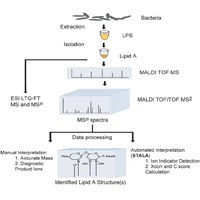contact
Shereece Singleton
Office Manager
F 410-706-0865
Characterization of Lipid A Modifications in Francisella, Burkholderia, and Yersinia subspecies
 Broad, long term objectives:
Broad, long term objectives:
Bacterial pathogens have evolved adaptive responses to environmental changes encountered upon entering a host. These responses include modifications of the bacterial cell envelope that enhance the ability to colonize, spread to different tissues, and avoid the host’s immune defenses. Modifications to essential cell membrane components, such as lipopolysaccharide (LPS), are important for pathogenesis. Lipopolysaccharide plays an essential role in maintaining membrane integrity and is a key factor in host innate immune recognition of gram-negative bacterial infections. LPS consists of three distinct regions: O-antigen, core, and lipid A. Both O-antigen and core consist of polysaccharide chains, whereas lipid A (or endotoxin) consists of fatty acid and phosphate moieties bonded to a central glucosamine dimer. Although lipid A is an essential component of all gram-negative bacterial membranes, it is a highly diverse molecule. Lipid A diversity is observed both in the number and length of fatty-acid side chains and in the presence of terminal phosphate residues and associated modifications. This variability could have profound implications for disease, particularly in humans, owing to altered recognition by the TLR4 complex. Structure–function analysis of lipid A signaling indicates that the length and number of acyl side chains are critical for TLR4 signaling in humans. Lipid A from E. coli is a highly immune stimulatory, even at low doses. In contrast, LPS isolated from F. tularensis or Y. pestis displayed little to no endotoxic properties.Therefore, alteration of the LPS structure may represent a pathogenesis strategy common to gram-negative bacterial species.
Hypothesis:
Francisella, Burkholderia, and Yersinia subspecies have unique lipid A structures. Synthesis of these unique structures in each organism contributes to pathogenesis and ultimately to protection from a lethal wild type challenge by the following mechanisms: (1) through altering host inflammatory responses, (2) increased bacterial resistance to host antimicrobial killing mechanisms, or (3) by activating the host adaptive immune system. We propose to study the relevance of lipid A structural variants to pathogenesis by identifying genes involved in their synthesis via the construction of isogenic mutant strains unable to synthesize specific lipid A structures in these bacterial backgrounds. Specific bacterial mutants in genes required for lipid A biosynthesis will be generated and tested in both in vivo (mouse virulence and lung inflammation) and in vitro (microbiological and tissue culture) models. These studies could lead to the identification of candidate drug targets that block the synthesis of various lipid A structures and render the bacteria more susceptible to host cell killing and/or conventional antibiotic intervention. Ultimately, these studies could lead to the identification of a new live vaccine strain or an improvement in the current generation of vaccines.
Goal of the specific research proposed:
I) Characterize unique lipid A structures present in clinical and environmental isolates of Francisella, Burkholderia, and Yersinia subspecies.
II) Characterize environmentally-regulated lipid A structures of Francisella, Burkholderia, and Yersinia subspecies.
III) Define genes required for the biosynthesis of environmentally-regulated lipid A structures of Francisella, Burkholderia, and Yersinia subspecies.
IV) Define the role of genes required for biosynthesis of unique lipid A structures for resistance to antimicrobial peptides, stimulation of host inflammation, virulence in in vivo assays, and potential utility in live vaccine strains.
